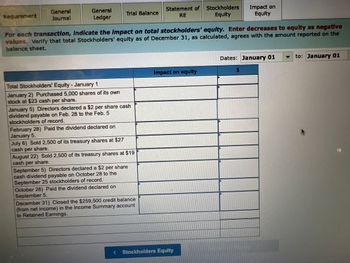Belray Company reports the following components of stockholders' equity on January 1. Common stock-$10 par value, 120,000 shares authorised, 50,000 shares issued and outstanding Paid-in capital in excess of par value, common stock Retained earnings Total stockholders' equity During the year, the following transactions affected Its stockholders' equity accounts. January 2 Purchased 5,000 shares of its own stock at $23 cash per share. January 5 Directors declared a $2 per share cash dividend payable on February 28 to the February 5 stockholders of record. February 28 Paid the dividend declared on January 5. treasury shares at $27 cash per share. August 22 Sold 2,500 of its treasury shares at $19 cash per share. July 6 Sold 2,500 of its September 5 Directors declared a $2 per share cash dividend payable on October 28 to the September 25 stockholders of record. October 28 Paid the dividend declared on September 5. December 31 Closed the $259,500 credit balance (from net income) in the Income Summary account to Retained Earnings. Requirement General Journal General Ledger Trial Balance Statement of Stockholders RE Equity $ 500,000 75,000 410,000 $ 985,000 Impact on Equity For each transaction, indicate the impact on total stockholders' equity. Enter decreases to equity as negative values. Verify that total Stockholders' equity as of December 31, as calculated, agrees with the amount reported on the balance sheet. Dates: January 01 to: January 01
Reporting Cash Flows
Reporting of cash flows means a statement of cash flow which is a financial statement. A cash flow statement is prepared by gathering all the data regarding inflows and outflows of a company. The cash flow statement includes cash inflows and outflows from various activities such as operating, financing, and investment. Reporting this statement is important because it is the main financial statement of the company.
Balance Sheet
A balance sheet is an integral part of the set of financial statements of an organization that reports the assets, liabilities, equity (shareholding) capital, other short and long-term debts, along with other related items. A balance sheet is one of the most critical measures of the financial performance and position of the company, and as the name suggests, the statement must balance the assets against the liabilities and equity. The assets are what the company owns, and the liabilities represent what the company owes. Equity represents the amount invested in the business, either by the promoters of the company or by external shareholders. The total assets must match total liabilities plus equity.
Financial Statements
Financial statements are written records of an organization which provide a true and real picture of business activities. It shows the financial position and the operating performance of the company. It is prepared at the end of every financial cycle. It includes three main components that are balance sheet, income statement and cash flow statement.
Owner's Capital
Before we begin to understand what Owner’s capital is and what Equity financing is to an organization, it is important to understand some basic accounting terminologies. A double-entry bookkeeping system Normal account balances are those which are expected to have either a debit balance or a credit balance, depending on the nature of the account. An asset account will have a debit balance as normal balance because an asset is a debit account. Similarly, a liability account will have the normal balance as a credit balance because it is amount owed, representing a credit account. Equity is also said to have a credit balance as its normal balance. However, sometimes the normal balances may be reversed, often due to incorrect journal or posting entries or other accounting/ clerical errors.

Trending now
This is a popular solution!
Step by step
Solved in 2 steps

Please fill in the blanks with blue arrows to the table above, the one you submitted back to me in response does not look like the same one I submitted









